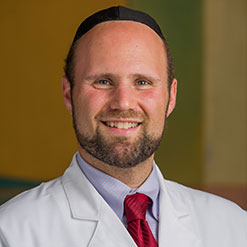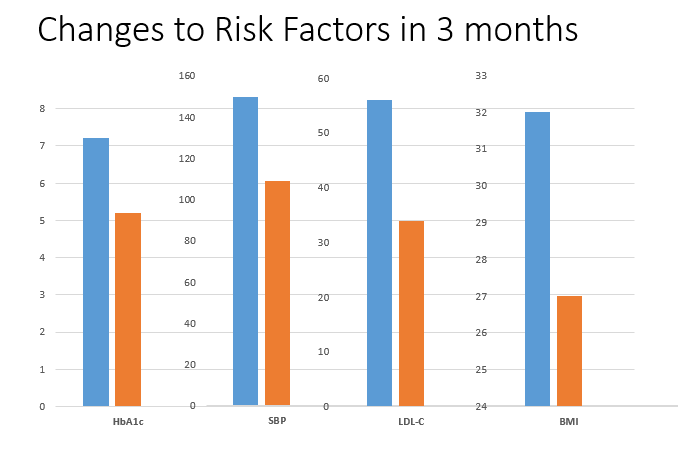Case Study Showcases Impact of Unique Cardiometabolic Program at University Hospitals Harrington Heart & Vascular Institute
July 13, 2022
Innovations in Cardiovascular Medicine & Surgery | Summer 2022
Now in its second year, the University Hospitals Center for Integrated and Novel Approaches in Vascular-Metabolic Disease (UH CINEMA) is demonstrating remarkable success in treating patients with Type 2 diabetes and cardiovascular risk profiles. The multidisciplinary team has accepted more than 600 referrals, but one of the first patients enrolled highlights the program’s tremendous outcomes.
 Ian Neeland, MD
Ian Neeland, MD Janice Friswold, RDN, CDES
Janice Friswold, RDN, CDES“In 2020, a 43-year-old gentleman with Type 2 diabetes came to see us because he was worried about a second cardiac event,” says Ian Neeland, MD, FAHA, FACC, Director of Cardiovascular Prevention and Co-Director of UH CINEMA within University Hospitals Harrington Heart & Vascular Institute. “In 2016, he presented with chest pain and was diagnosed with myocardial infarction and multivessel disease requiring two stents.”
That same year, he experienced amaurosis fugax, a transient ischemic attack (TIA) localized within the eye. From 2016 to 2020, he was followed by a cardiologist with no further cardiac events. However, he enrolled in UH CINEMA to take additional proactive steps toward improving his health and reducing future risk.
Extensive assessment
In addition to a standard history and physical, individuals entering the UH CINEMA program receive advanced testing and imaging. “When this patient came to us, he hadn't addressed much of his risk factor burden through lifestyle changes,” says Dr. Neeland. “He was taking basic secondary prevention measures, including low-dose aspirin, a statin, Metoprolol for blood pressure and twice-daily Metformin for his diabetes.”
Although his LDL cholesterol was well-controlled at 56 mg/dl, his cholesterol particles were small and dense. His triglycerides were elevated, and hypertension was not well-controlled at 142/80 mmHg. With a hemoglobin A1C marker of 7.2 percent, his diabetes control was classified as borderline. Cardiac MRI showed well-preserved heart function and no evidence of overt thoracic or arch atherosclerosis. He was diagnosed with atherogenic dyslipidemia profile and metabolic syndrome. Contributing risk factors included his South Asian ancestry, a prior history of smoking and a body mass index (BMI) of 32.
A holistic treatment plan

UH CINEMA leverages expertise and resources throughout the health system to provide an unprecedented level of integrated cardiometabolic care. Patients begin with a single appointment that provides access to physicians, nurse navigators, certified diabetic educators, registered dietitians and pharmacists.
“Much of what we focused on with this patient was lifestyle modification,” says Dr. Neeland. “Our goal was to completely change his dietary pattern, encouraging foods from the Mediterranean and DASH diets: whole grains, legumes, healthy nuts and oils, low-fat dairy, high potassium and low sodium. We aim for about five to 10 percent weight loss over the first three to six months.” Other recommendations included increased aerobic activity and resistance training. The team was aggressive with blood pressure therapy, targeting readings below 130/80. They also added Ozempic® (semaglutide), a once-weekly, non-insulin injection prescribed to control blood sugar and improve A1C levels. A GLP-1 receptor agonist, Dr. Neeland explains, is a drug that works on multiple fronts. “It decreases visceral fat and resolves a lot of inflammation and metabolic disarray that occurs in patients with diabetes and metabolic syndrome and has been shown to reduce cardiovascular events,” he says.
Education and support
Contributing to the program’s success is an investment in patient-centered education and peer support. “We start where patients are and help them set smart goals,” says Janice Friswold, RDN, CDCES. “When addressing a healthcare problem, it takes a village to facilitate healthy behaviors and change processes. I’ve found that when patients understand and set their own goals, they are able to achieve them and build on each small success.”
In addition to individualized treatment plans, patients have access to weekly educational sessions that remain available on the UH CINEMA website and monthly peer-led support groups. Friswold is also working to implement a culinary medicine program, helping patients create healthy meals and incorporating competition-style cooking events. “Jan and Elke Eaton, our nurse navigator, follow patients at regular intervals,” says Dr. Neeland. “There are many touchpoints along the journey to make adjustments and recommendations.”
Life-changing results
Three months from his initial visit, the patient showed significant progress. He reduced his BMI to 27, achieved his LDL-C target and lowered his blood pressure and A1-C. And he is not alone. A review of 113 UH CINEMA patients documented improvement from baseline for eight contributing cardiometabolic risk factors within the first three months of treatment.


“Over time, these outcomes translate to fewer adverse cardiometabolic events, reduced hospitalizations and better healthcare utilization,” says Dr. Neeland. “Most importantly, we are positively impacting patients’ lives.”
The reach of the innovative program is extending beyond Cleveland. In 2021, UH CINEMA leaders were invited to participate in the American Diabetes Association’s Thought Leadership Film Series. This May, the team hosted an in-person and virtual symposium featuring international thought leaders in diabetes management.
“The event was a celebration and opportunity for UH to host experts in the field discussing state-of-the-art diabetes care,” says Dr. Neeland.
For more information or to refer a patient, call 216-844-1357 or email CINEMA@UHhospitals.org.
Contributing Experts:
Ian Neeland, MD, FAHA, FACC
Director of Cardiovascular Prevention
Co-Director of the Center for Integrated and Novel Approaches in Vascular-Metabolic Disease (UH CINEMA)
University Hospitals Harrington Heart & Vascular Institute
Associate Professor
Case Western Reserve University School of Medicine
Janice Friswold, RDN, CDCES
Registered Dietitian and Certified Diabetes Educator
Center for Integrated and Novel Approaches in Vascular-Metabolic Disease (UH CINEMA)
University Hospitals Harrington Heart & Vascular Institute


